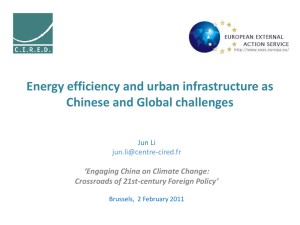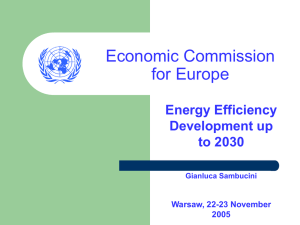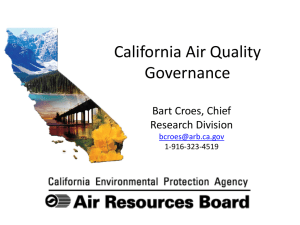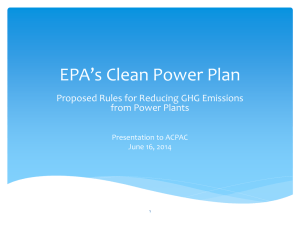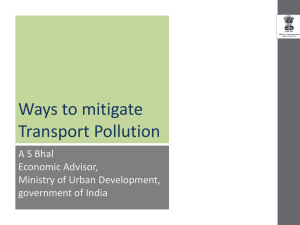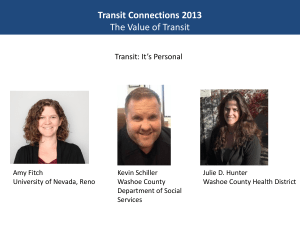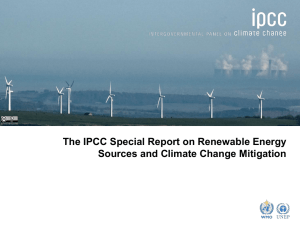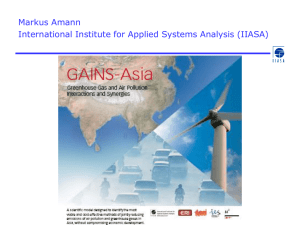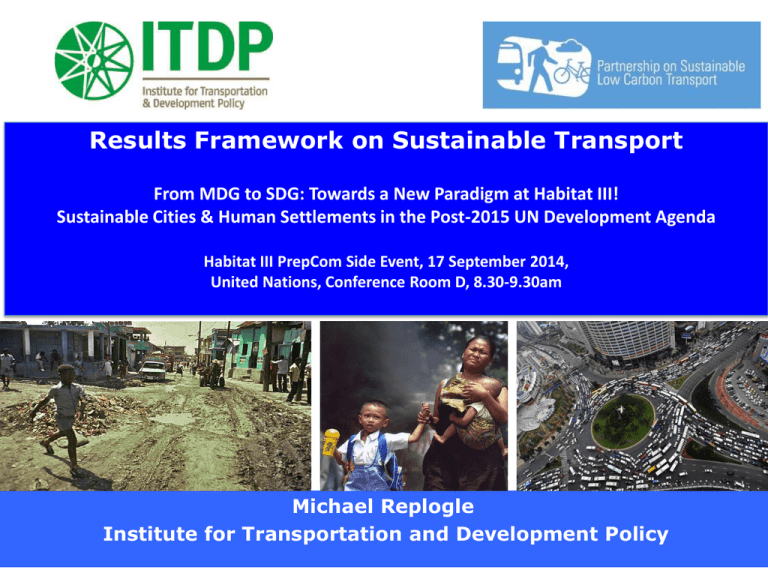
Results Framework on Sustainable Transport
From MDG to SDG: Towards a New Paradigm at Habitat III!
Sustainable Cities & Human Settlements in the Post-2015 UN Development Agenda
Habitat III PrepCom Side Event, 17 September 2014,
United Nations, Conference Room D, 8.30-9.30am
Michael Replogle
Institute for Transportation and Development Policy
Need for Paradigm shift on development of transport
Predict and Provide
Build Roads to promote
economic and social
development
Road safety
1.3 million
deaths
Air Pollution
3 million
deaths
(large part
transport)
Climate
change –
transport
GHG fast
growing
Congestion
Access not inclusive –
large groups no
access
(urban and rural)
Negative externalities of old paradigm:
6-10% of GDP at least 50 Trillion USD up to 2030
SLoCaT Results Framework
Improving Access
Rural Access
Secure universal access by sustainable
transport for rural populations by 2030
Urban Access
Target
Secure universal access by sustainable
transport for urban populations by 2030
National
Access and
Regional
Connectivity
Facilitate national inclusion and regional
connectivity by sustainable multi-modal freight
and passenger services by 2030
SLoCaT Results Framework
Reducing Negative
Externalities
Road Safety
Halve road traffic deaths by 2030 compared to
2010
Air Pollution
and Human
Health
Halve premature deaths from road related
traffic air pollution by 2030 compared to 2010
GHG Emissions
Total world transport-related GHG emissions peak
no later than 2020 then begin to decline at 2% per
year rate, with 2030 transport-related emissions no
higher than 2010 emissions
SLoCaT Targets vis-à-vis proposed SDGs
Rural
Access
Road
Safety
Urban Access
Target
Air Pollution
and Human
Health
National Access
and Regional
Connectivity
GHG
Emissions
Proposed goal 11. Make
cities and human
settlements inclusive,
safe, resilient and
sustainable
Proposed goal 2. End
hunger, achieve food
security and improved
nutrition, and promote
sustainable agriculture
Proposed goal 3. Ensure
healthy lives and promote
well-being for all at all
ages
Proposed goal 7. Ensure
access to affordable,
reliable, sustainable and
modern energy for all
Proposed Goal 9: Built
resilient infrastructure,
promote inclusive and
sustainable
industrialization and
foster innovation
Proposed goal 12. Ensure
sustainable consumption
and production patterns
Proposed goal 13. Take
urgent action to combat
climate change and its
impacts
Transportation Has Long Been on the UN Urban Agenda
Agenda 21:
1992 UN Conference in Environment and Development
Transportation strategies should reduce the need for the motor
vehicles by favouring high-occupancy public transport, and
providing safe bicycle and footpaths. Municipalities need to be
developed in ways that reduce the need for long-distance
commuting…
Developing countries need financial and technical assistance to
help train experts in such fields as urban planning,…and clean,
efficient transportation. (Sec.1, Ch.7)
Agenda 21: 1992 UN Conference in Environment and Development
Transportation is essential for economic and social development, and the
need will undoubtedly increase, but this activity is also a source of
atmospheric emissions. Governments should:
• Promote national energy efficiency and emission standards, and
increase public awareness of environmentally sound energy systems.
• Develop efficient, cost-effective, less polluting and safer rural and
urban mass transit, along with environmentally sound road networks.
• Encourage forms of transportation that minimize emissions and
harmful effects on the environment.
• Plan urban and regional settlements to reduce the environmental
impacts of transport. (Sec.2, Ch.9)
Johannesburg Plan of Implementation,
2002 UN World Summit on Sustainable Development
Followed example of Agenda 21…
Promote an integrated approach to policy-making at the national,
regional and local levels for transport services and systems to
promote sustainable development, including policies and planning
for land use, infrastructure, public transport systems and goods
delivery networks, with a view to providing safe, affordable and
efficient transportation, increasing energy efficiency, reducing
pollution, reducing congestion, reducing adverse health effects and
limiting urban sprawl, taking into account national priorities and
circumstances.
Johannesburg Plan of Implementation,
2002 UN World Summit on Sustainable Development
This would include actions at all levels to:
(a) Implement transport strategies for sustainable development,
reflecting specific regional, national and local conditions, so as to
improve the affordability, efficiency and convenience of
transportation, as well as improving urban air quality and health, and
reduce greenhouse gas emissions, including through the development
of better vehicle technologies that are more environmentally sound,
affordable and socially acceptable;
(b) Promote investment and partnerships for the development of
sustainable, energy efficient multi-modal transportation systems,
including public mass transportation systems and better
transportation systems in rural areas, with technical and financial
assistance for developing countries and countries with economies in
transition.
Commission on Sustainable Development
There is a strong need for adequate and efficient, economically
viable, socially acceptable and environmentally sound transport
systems, especially in developing countries, where accessibility
and affordability are important for the eradication of poverty,
improving access to social services and access to employment
opportunities. Prospects for achieving sustainable development
depend on taking transport into account in urban and rural
planning, public infrastructure decisions, and policies and
measures to eradicate poverty and promote gender equality.
(CSD Decision 9/3 (2003))
Millenium Development Goals
Passenger
Eradicate extreme poverty and hunger
Achieve Universal primary education
Promote gender equality and empower women
Transport
Reduce Child Mortality
Improve Maternal Health
Combat HIV/AIDS, Malaria and other dieseases
Ensure Environmental Sustainability
Freight
Develop a Global Partnership for Development
Still Rising
•
•
•
•
•
•
Traffic deaths
Traffic related air pollution
Inequality of access
Non-renewable fossil fuel use
Transport GHG emissions
Lock-in of high carbon,
unsustainable transport and
urban development patterns
• Motor vehicle dependence
• Private motor vehicle trip share
Also Rising
• National urban transport laws,
policies, funding programs
• Stringency of motor vehicle
emission standards
• Stringency of motor vehicle fuel
economy standards
• Efforts to cut fossil fuel subsidies
• High quality Bus Rapid Transit
• Public bike programs
• Parking reforms
• Green logistics initiatives
• Awareness that sustainable
transport is vital enabler of
sustainable development
Integrated
Mobility and
Access
Management
Demand side
Supply side
New
highways
Adding
lanes
HOV
lanes
Traffic
operations
Expanded rail
systems
Toll roads
Public
bike systems
BRT
systems
HOT
lanes
Integrated
Housing
Policy
Integrated
Land Use
Traffic
calming
Public transport
priority
Parking
control
Congestion
charges
Information
systems
Taxation
policy
What Is Needed to Take Sustainable Transport to Scale?
Effective means of implementation
• Financial capacity where the work must be done
• Smart prioritization of spending and borrowing
• Institutional capacity: national/regional/local
• Interagency coordination/integrated planning
• Institutional support to develop the pipeline of
investable sustainable transport initiatives
• Data collection, monitoring, analysis, reporting
• Engagement with civil society and other partners
to support disruptive collaborations
Finance Framework on Sustainable Transport
1. Pass-on costs to Users
2. Redirect Public Sector Funding
3. Leverage – engage private sector funding
4. Redirect ODA
5. Better utilization of climate
finance
Redirect Priority to Where it should be
Open Working Group Recommended Sustainable Development Goal
on Cities and Human Settlements Includes
Target 11.2 -- By 2030, provide access to safe,
affordable, accessible and sustainable transport
systems for all, improving road safety, notably by
expanding public transport, with special attention to
the needs of those in vulnerable situations, women,
children, persons with disabilities and older persons.
How Could Target 11.2 Be Improved?
By 2030, provide access to safe, affordable, accessible,
clean, and energy-efficient [sustainable] transport
systems for all, improving road safety, [notably by]
expanding public transport, enhancing goods movement,
walking, and cycling, with [special] attention to the
needs of those in vulnerable situations, women, children,
persons with disabilities and older persons
Possible Indicators for Target 11.2
• Rapid public transport (rail and BRT) km per million urban
population (by mode)
• Mean daily travel time for people by mode (by income
quintile)
• Share of income spent by urban families on transport (by
income quintile)
• Share of trips by public transport, cycling, walking, and
other sustainable modes, and motor vehicle occupancy (by
income quintile)
• Average trip length in km in metropolitan areas (by mode)
• Average load factor for freight vehicles (by vehicle class)
• Share of streets, public transport vehicles, public transport
stops, and buildings accessible to persons with disabilities
• Number of assaults on public transport vehicles (by sex)
Possible Secondary Indicators for Target 11.2
• Share of people living within 500 meters of public transit
running at least every 20 minutes during peak times (by income
quintile)
• Number of freight consolidation centers
• Number of public bicycles and population served by public bikes
• Km of cycleways (protected and dedicated lanes)
• Share of urban dwellers engaging in outdoor physical exercise
• Intersection density and average block size
• Change in urban land area vs. change in urban population
• Share of streets with connected sidewalks
• Share of blocks with heterogeneous land uses (shops, homes)
• Floor area ratio of developed land
Transport Tackles Climate Change
@ Transport Day 2014
www.slocat.net/transportday2014
© Global Fuel Economy Initiative
December 7th, 2014
Sheraton Lima Hotel, Lima, Peru
Organized by:
For more information on SLoCaT:
Cornie Huizenga, Secretary
General
Partnership on Sustainable Low
Carbon Transport
www.slocat.net
Supported by:

